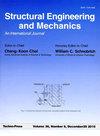Effect of nonlinear FG-CNT distribution on mechanical properties of functionally graded nano-composite beam
IF 3
4区 工程技术
Q2 ENGINEERING, CIVIL
引用次数: 57
Abstract
This work focused on the novel numerical tool for the bending responses of carbon nanotube reinforced composites (CNTRC) beams. The higher order shear deformation beam theory (HSDT) is used to determine strain-displacement relationships. A new exponential function was introduced into the carbon nanotube (CNT) volume fraction equation to show the effect of the CNT distribution on the CNTRC beams through displacements and stresses. To determine the mechanical properties of CNTRCs, the rule of the mixture was employed by assuming that the single-walled carbon nanotubes (SWCNTs)are aligned and distributed in the matrix. The governing equations were derived by Hamilton's principle, and the mathematical models presented in this work are numerically provided to verify the accuracy of the present theory. The effects of aspect ratio (l/d), CNT volume fraction (Vcnt), and the order of exponent (n) on the displacement and stresses are presented and discussed in detail. Based on the analytical results. It turns out that the increase of the exponent degree (n) makes the X-beam stiffer and the exponential CNTs distribution plays an indispensable role to improve the mechanical properties of the CNTRC beams.非线性FG-CNT分布对功能梯度纳米复合梁力学性能的影响
本文研究了碳纳米管增强复合材料(CNTRC)梁弯曲响应的新型数值计算工具。采用高阶剪切变形梁理论(HSDT)确定应变-位移关系。在碳纳米管(CNT)体积分数方程中引入了一个新的指数函数,以表征碳纳米管的分布通过位移和应力对CNTRC梁的影响。为了确定CNTRCs的力学性能,采用混合规律,假设单壁碳纳米管(SWCNTs)在基体中排列并分布。根据汉密尔顿原理推导了控制方程,并给出了数学模型,以验证理论的准确性。详细讨论了长径比(l/d)、碳纳米管体积分数(Vcnt)和指数阶(n)对位移和应力的影响。根据分析结果。结果表明,指数度(n)的增加使x梁的刚度增大,CNTs的指数分布对提高CNTRC梁的力学性能起着不可缺少的作用。
本文章由计算机程序翻译,如有差异,请以英文原文为准。
求助全文
约1分钟内获得全文
求助全文
来源期刊

Structural Engineering and Mechanics
工程技术-工程:机械
CiteScore
3.80
自引率
18.20%
发文量
0
审稿时长
11 months
期刊介绍:
The STRUCTURAL ENGINEERING AND MECHANICS, An International Journal, aims at: providing a major publication channel for structural engineering, wider distribution at more affordable subscription rates; faster reviewing and publication for manuscripts submitted; and a broad scope for wider participation.
The main subject of the Journal is structural engineering concerned with aspects of mechanics. Areas covered by the Journal include:
- Structural Mechanics
- Design of Civil, Building and Mechanical Structures
- Structural Optimization and Controls
- Structural Safety and Reliability
- New Structural Materials and Applications
- Effects of Wind, Earthquake and Wave Loadings on Structures
- Fluid-Structure and Soil-Structure Interactions
- AI Application and Expert Systems in Structural Engineering. Submission of papers from practicing engineers is particularly encouraged.
 求助内容:
求助内容: 应助结果提醒方式:
应助结果提醒方式:


